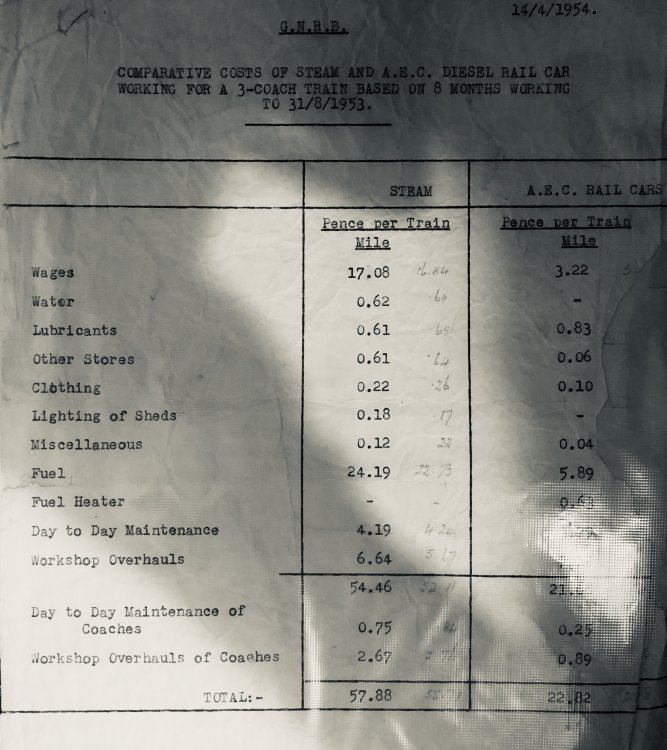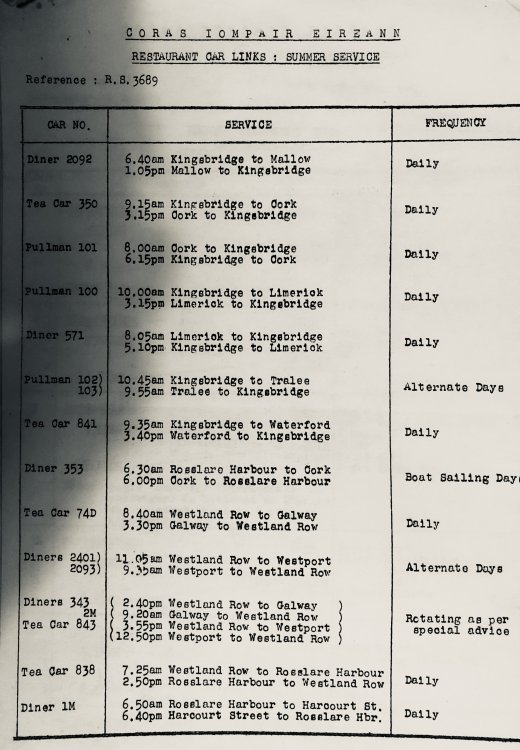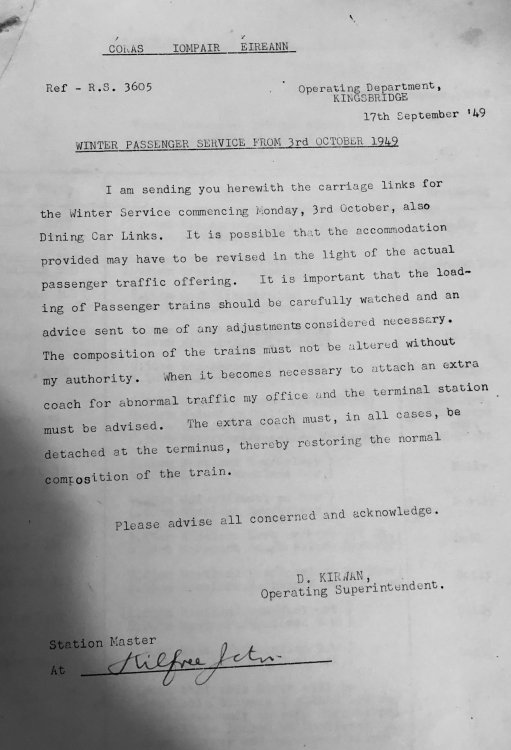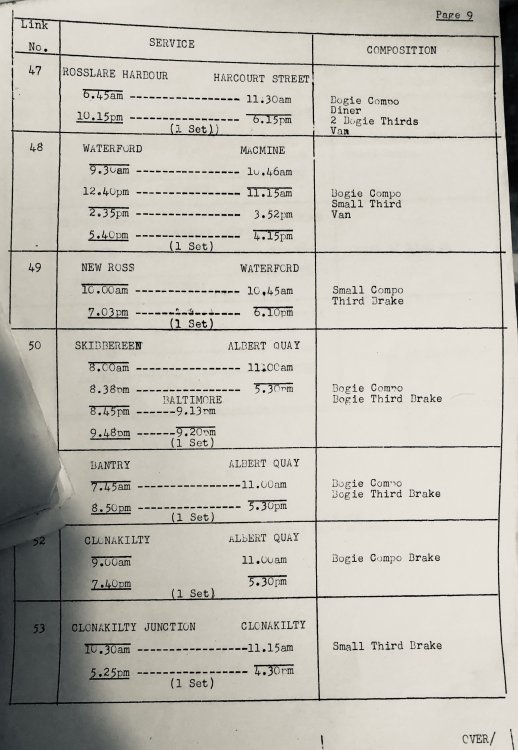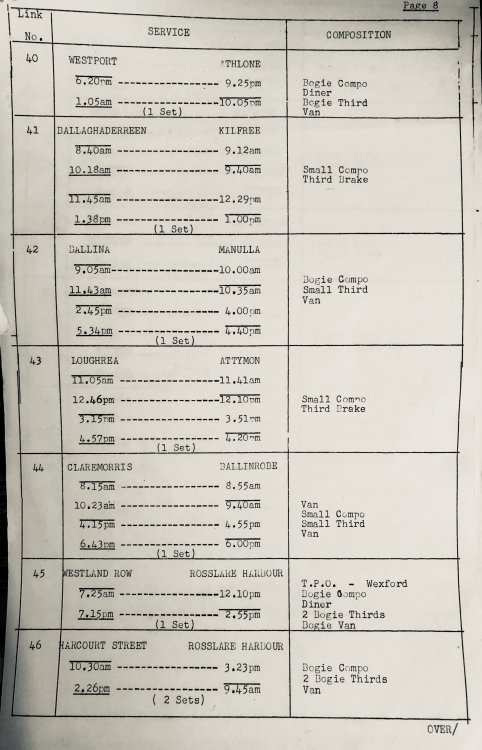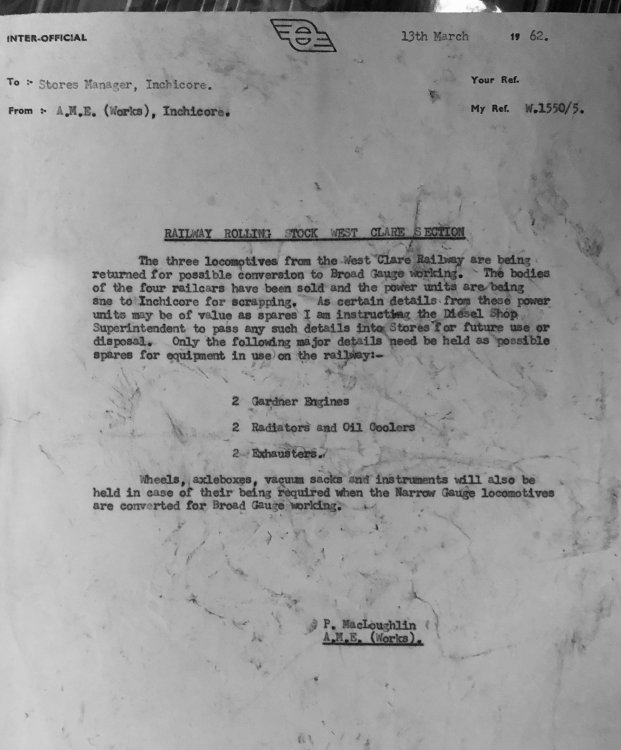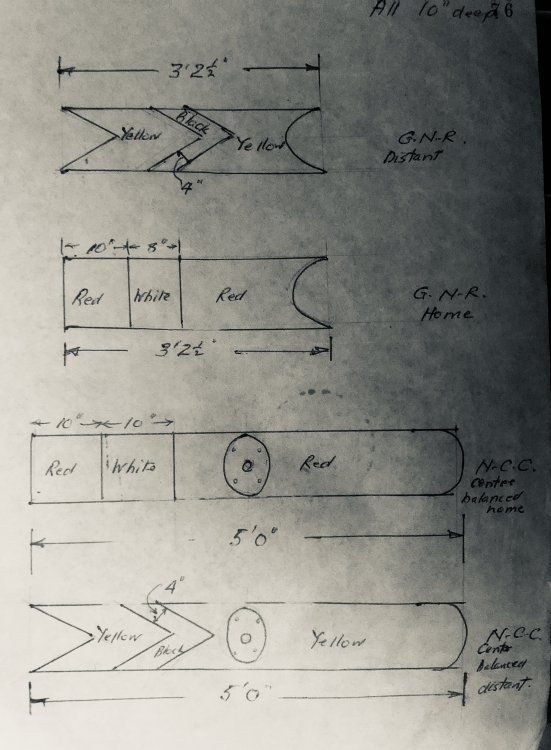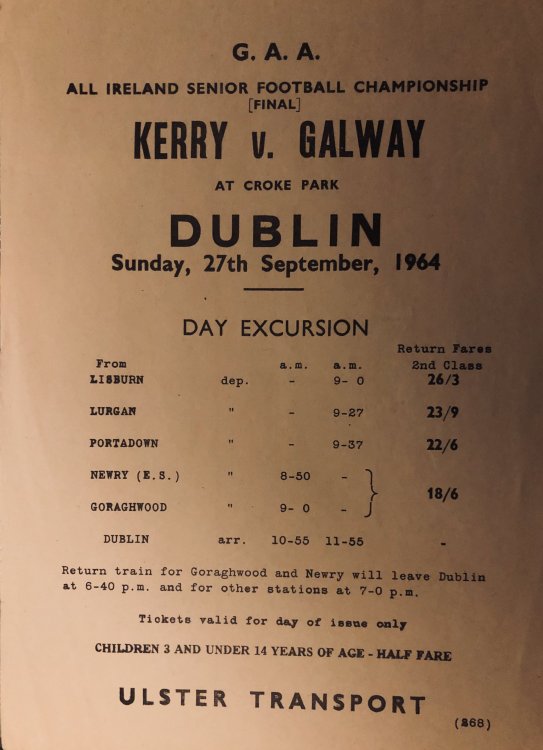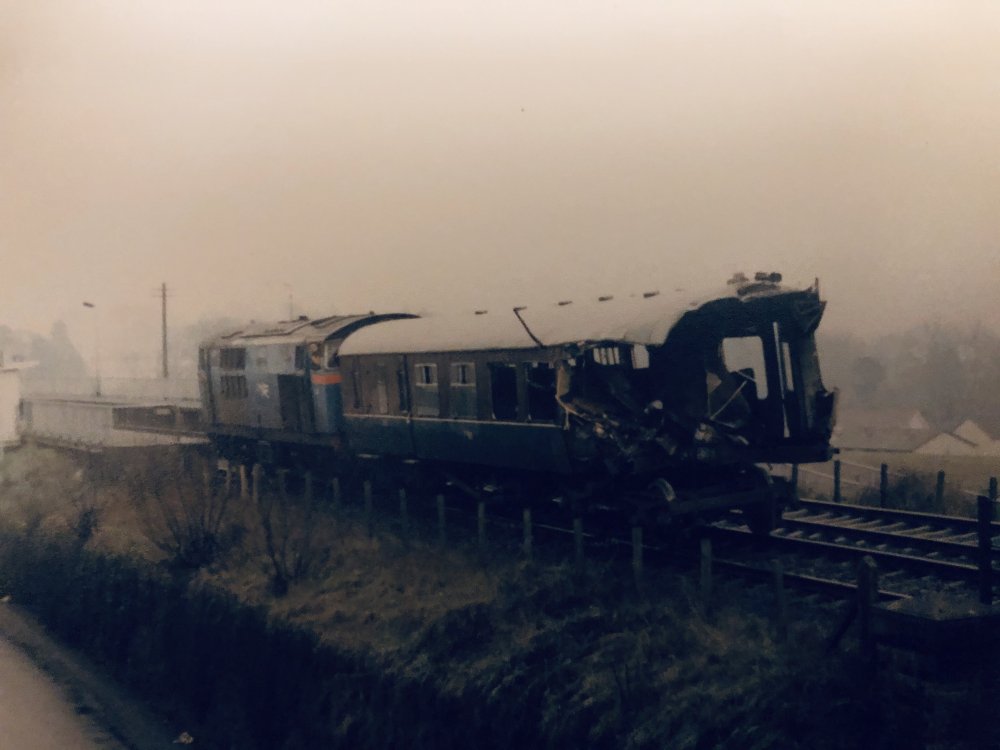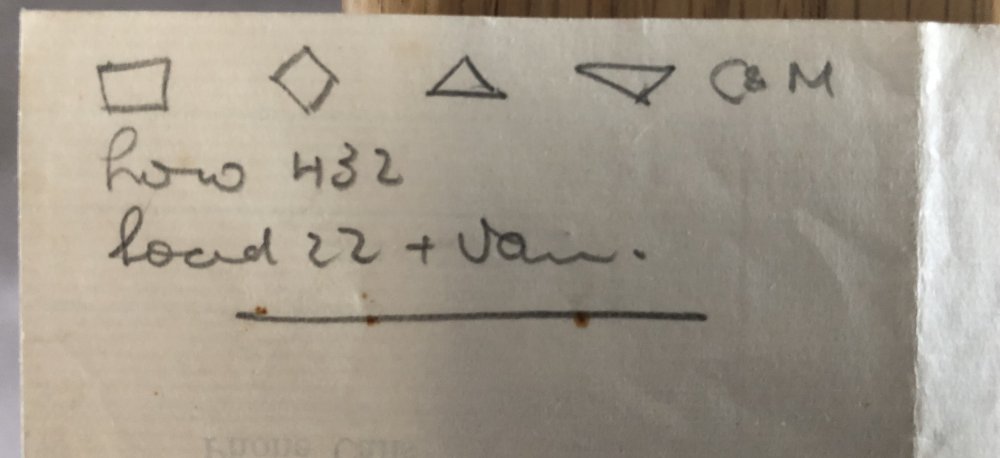-
Posts
15,408 -
Joined
-
Last visited
-
Days Won
374
Content Type
Profiles
Forums
Resource Library
Events
Gallery
Blogs
Store
Community Map
Everything posted by jhb171achill
-
Very true! Then I'm flummoxed!
-
CARRIAGE ALLOCATIONS 1949/50 This gives an idea of train consists seventy years ago. Sounds a long time, but only a few years ago, nobody was modelling anything much before 1975. Then we got well into the black’n’tan era. Now, with J15s, A, C, B101,121,141,181, E & G classes, laminates, Park Royals, Tom vans, various loose-coupled goods vehicles, we’re into the “grey’n’green” era. One step more and this stuff’s of use. Now - the carriage allocations are of interest to anyone wanting to create a 1950s / early 60s branch line scene, as perusal of the attached lists show what trains were typically made up of. I say "typically"; on days like fair days, and extra coach might be added. If the normal branch set was taken away for maintenance, gawd knows what they might put in there instead. Senior told of a jaunt down some branch in the 1950s with a quite new CIE "Bredin-design" coach, probably only a few years old, with an absolutely ancient, clapped out MGWR 6-wheel brake third behind it. For anyone interested. I have this list to cover THE WHOLE CIE SYSTEM FOR 1949 / 50, main lines an'all. So if anyone wants to know what was on any specific line, ping me privately and I'll send it to you. The GNR's perusals of running costs for AEC cars crept in here too.....
-
The locos weren't too varied, Colin, but the carriages were actually painted at least three distinct reds. Most were much as now, but some were a maroon and cream colour. The so-called "F" "Saloons" were painted pillar-box-red all over in the 1970s. As far as the locos were concerned, what happened with the different pigments that you mention, was that while locos looked the same (and were, to all intents and purposed) when newly painted, different batches of paint faded at different rates. Thus, some would look a bit more brownish in time, others not. Weathering and filth, as with all things steam, never helped! (I'm assuming you're another IOMR enthusiast, like me....)
-
Walker Diesel Class F - ECMbuild in 4mm for OOn3
jhb171achill replied to murrayec's topic in Irish Models
- 136 replies
-
- 1
-

-
- class f
- west clare
-
(and 1 more)
Tagged with:
-
The attached is a diagram with measurements from the UTA’s drawing office about 1959. Useful for modellers of the GNR, NCC, UTA and early NIR.
-
Could be, porky! It wasn't the only "cryptic" note he left behind!
-
Housebound by the Coronavirus (or is it Brexit? I'm getting senile here in the Catacombs...) I was having a rummage today for something that I was asked about. As usual, I still haven't found what I was looking for, á la U2. But I did find a few odds and ends, as follows. Quiz question: the pranged 70-class; where & when? (Colin McL, I know that you know!! )
-
The Hendry brothers and James Boyd were a powerhouse of information on the IOMR. I very much suspect that they WERE just “too alike”; in my fifty years of bumbling about within the railway world, the railway historical world, enthusiast and preservation worlds, I’ve met all sorts. And some are pure geniuses at their chosen interests. In every single hobby, we have our balanced and unbalanced eccentrics and the occasional outright oddball! Tis part of what makes, eh, life’s rich tapestry so interesting.... James didn’t suffer fools, and nor did Cyril Fry. Anecdotal evidence suggests the Hendrys didn’t either. It’s very probable that none of them had much time for each other! However, all four made a monumental contribution to our knowledge of railways, and for that we may be very grateful. I had Boyd’s books on the IOMR devoured cover to cover before we ever met - and that was when I was 19....
-
Learned colleagues; I attach a scribbled note among some of jhb171Senior’s papers. It’s on the back of a bit of paper used as a bookmark in an old magazine. I assume it’s a note of a load on a trsin hailed by 432, but what’s the rest? I suspect it’s the designs of MGWR mileposts, unless it’s symbols associated with suburban trains? Any thoughts?
-
Indeed! And the odd “H” van STILL carrying a “flying snail”.....
-
What I liked about the laminates was the sheer variety. Anyone who hasn’t got it, try to get via fleabay the first edition of “Irish locomotives and rolling stock”, a small but very comprehensive “spotters book” by Oliver Doyle & Stephen Hirsch, published in the 1980s. You’ll be amazed at the various permutations of all things laminate.... Even the next edition of it, after which much of this stuff is withdrawn, is fascinating. But a 1962 edition would have been the size of seven New York telephone directories due to the sheer variety of everything, and numerous one-off variations!
-
No book specifically about them, but a number of books cover CIE’s 1955-63 railway modernisation programme. To get the whole story, we need to go back to the GSR modernisation programme which resulted in the 1933, 1935 and 1937 “Bredins”, and the follow-up series of new CIE coaches in 1951-3. The bulk of what were known as “laminates” were a follow on from these, built 1956-61. The pic appears to be a brand new rake, probably among the last built. Just a short time after that, the Cravens were introduced.... Last of them were withdrawn in the late 1980s.
-
Fairly new “laminates” in original green livery.
-
I hope it was Guinness. One must maintain standards, even in the face of adversity.....!
-
I was thinking the same! Disclaimer: if I have the virus and anyone reads this... ah, it's too late now. Youv'e read it......
-
Amazing!!!! Superb job as always
- 24 replies
-
- 1
-

-
Indeed; I stand humbly corrected!!
-
Looking amazing, Brian! That lot will look amazing behind an "A"......
-
Are the old MIR ones metal or plastic? Metal, I think??
-
I heard of at least one occasion last year when a group of "hens" going to Killarney were extremely abusive to other passengers and threatened to assault one.....
-
Good stuff, hexagon. Yes, several Cravens were indeed upgraded to 1st for a short time. All they did was put antimacassars on the seats and paint a "1" on the doors!
-
I can perhaps illustrate it like this, albeit extremely crudely: BTB, you'll see many pics in books of both steam and diesel locomotives (and buses, carriages, railcars and wagons) showing the "flying snail". Dublin trams too, going back to 1941. Some of these also had the bus-style reversed symbol. What is below ticked in green, and on my avatar thingy to the left here, is the "right way round", with the "wings" on the top left, not top right. All diesel locos should have it the other way round from shown on the model. So should absolutely everything else on the railway, bar ONE side of steam loco tenders. No. Diesel locos can go in both directions, thus it doesn't matter which side - it should be the "normal" logo, not this reversed one shown. No diesel loco ever carried one like that.
-
I was in Galway last night. Bars were noticeably quieter..... get yer masks on. A genny van with a missing wheel plus a bottle of hand sanitiser - bargain for €9,000.
-
I believe line speed was indeed 70 on the Cork and Belfast lines (though not necessarily the entire routes). I was doing a “rail runabout” that summer, and while I can’t confirm exactly what carriages were on what services, I can confirm that not everything was Mk 2. The mid-morning Cork was an 11, 12 or 13 coach rake of mixed laminates of several types, Cravens and Park Royals. The “Enterprise” was laminates and Park Royals, as CIE didn’t want to risk the better Cravens and Mk2s. (By the way, Mk. 2s were more often than not known as “a/c stock”....) Rosslare-Limerick-Claremorris was PRs & various laminates, as were Cork & Dublin suburbans, and Tralee. At least one afternoon train to Cork was old stock too. It was around then that I travelled in what must have been one of the very last Bredins. I never saw one in traffic again. I travelled in Mk 2 stock to Waterford, Cork and Galway. Sligo was, I THINK, a mixture. I certainly travelled on two trains on this line which were not Mk 2, but (a) one was the up evening mail which wasn’t advertised and (b) I can’t state what stock was on ALL trains on the Sligo line. I travelled on one up Westport and took a pic of another - Cravens & laminates. I remember this in particular, as the ticket checker got into a row with a gentleman of somewhat rural disposition, who insisted on smoking in the (24xx type) dining car. He told him in words unfamiliar to the easily-offended in today’s PC and over-sensitive world, what he would do with him and where he might put his cigarette if he didn’t stop! Our rural friend eventually settled down and went to sleep, dreaming peacefully perhaps after counting his own favourite sheep..... I think he had had a few sips of falling-down lotion..... And yes, the in-seat stuff was almost certainly the Mk 2s. I’m not sure if there were too many non-a/c 1st class carriages in use.
.png.c363cdf5c3fb7955cd92a55eb6dbbae0.png)

